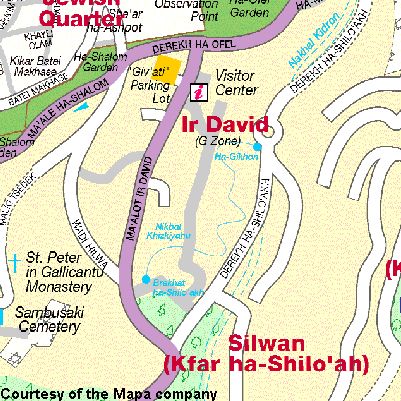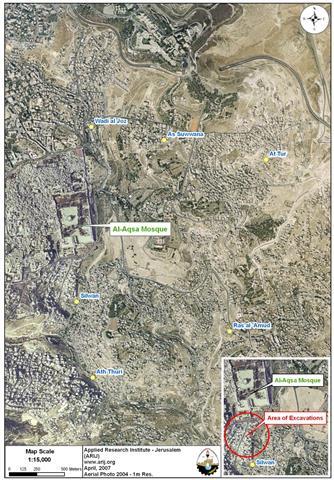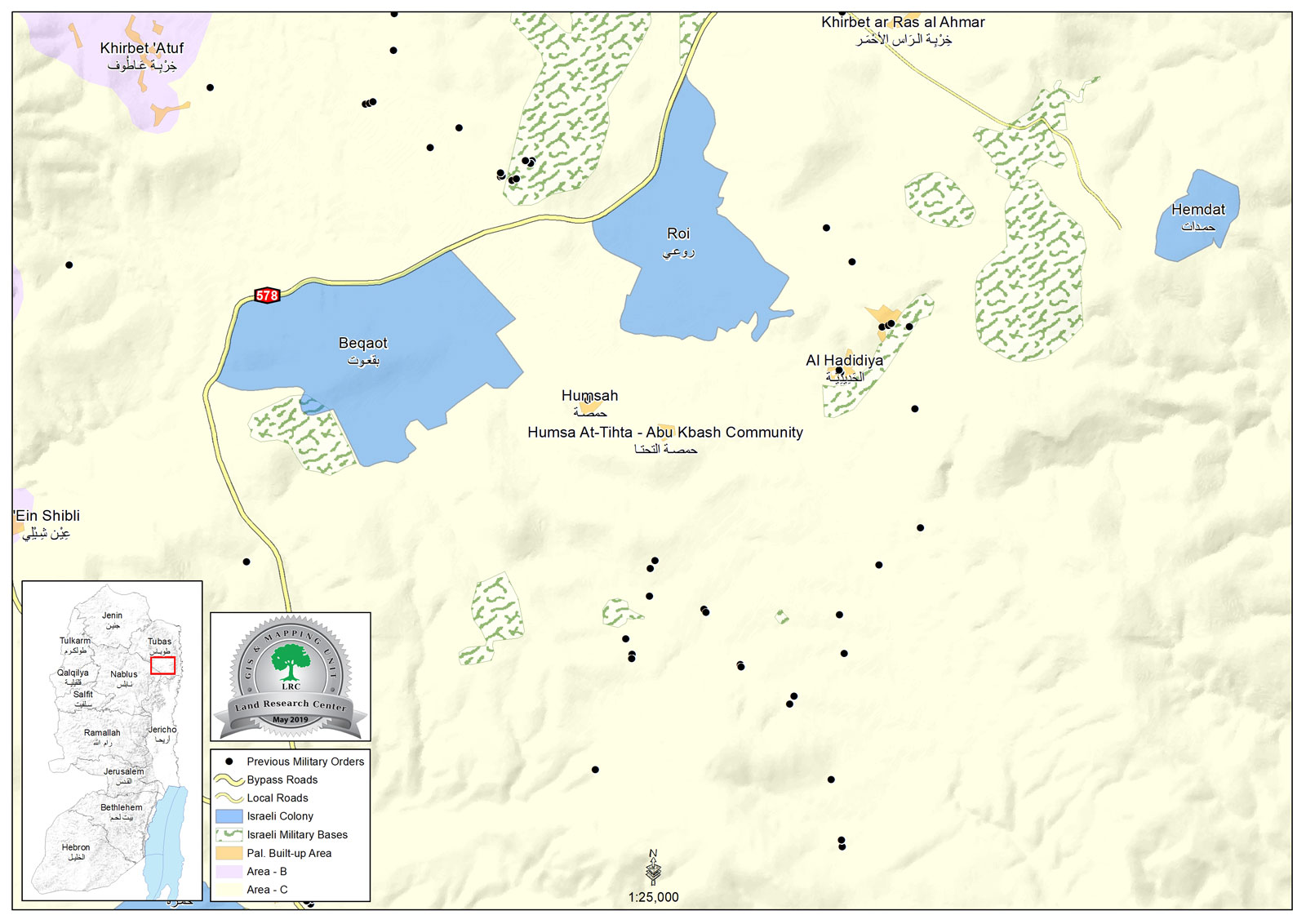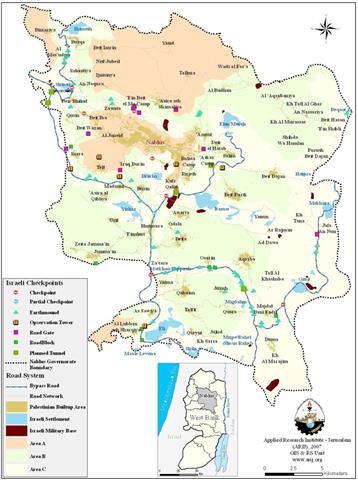Overview
Silwan is a Palestinian town located southeast of Jerusalem’s Old City. The town extends along the Kidron Valley and runs alongside the eastern slopes of Jabal Al-Mukaber. It is located outside the southern walls of the Old City of Jerusalem. Al Aqsa Mosque surrounds the town at its northern side, Al Thouri neighborhood at its southern side, the Palestinian villages of Abu Dis, Izzariya from its eastern side and the heart of East Jerusalem lays to its west. Since the occupation of East Jerusalem in 1967, the town has been targeted by the Israeli government as well as by Jewish organizations. Ateret Cohanim and the ELAD Jewish foundations are examples of these organizations. ELAD foundation was established in 1986 with the aim of constructing what is called ‘city of David’ in the place that is home to the Silwan residents for hundreds of years. Furthermore, the town has been a center of controversial Israeli excavations from decades to come and one of the main sources of tension in occupied East Jerusalem.
Moreover, it is worth mentioning that Silwan hosts dozens of Palestinian families after the fled the Israeli aggression in 1967, when Israel occupied East Jerusalem along with the west bank and Gaza and these families were expelled from the Moroccan quarter in the Old City as the Israeli Army commenced hours after their occupation a systematic demolishing process in a desperate attempt to locate the alleged location of the Temple Mount, which ended with them finding nothing. The Moroccan quarter was permanently handed to Jewish religious society to reenvote and resides in and the expelled Palestinian residents were never allowed to return. Today, these families are facing, yet again, another threat of expulsion and demolishing to heir residents some 40 years after.
The colonization attack on Silwan started escalating in 1991, when Jewish settlers coarsely seized more than 40 houses. On the maps issued by the Israeli government and various Jewish organizations, part of Silwan is labeled as the ‘City of David’ (Ir David in Hebrew), more than that, the street signs also indicated directions to ‘Ir David’ without mentioning Silwan, despite the fact that this neighborhood is almost entirely owned and inhabited by the Palestinians. Wadi Hilwe neighborhood in Silwan is a section of the part labeled ‘Ir David’ and was the most targeted one because of its proximity to the western wall of the Old City. See the Map Below:

Source of map: http://www.jerusalem.muni.il/jer_main/f1_main.asp?lng=2
Baseless Israeli Allegations
The threat on Silwan always came in methodical frame starting with the consecutive Israeli governments’ and Jewish religious groups’ claim that this Palestinian town: Silwan; was built on the ruin of what they believe to be the location where the City of David used to be; and even though and in spite of the excavations and researches they conducted over the past 40 years, they were unable to remotely prove their claim. Nonetheless, Silwan remains to be a constant target to Israeli bullying procedures starting from confiscation of private Palestinian lands, or by seizure of Palestinian houses by Jewish settlers with the support of official Israeli authorities, but mostly by the systematic house demolitions.
Another Deluded Excavation
Since the beginning of 2007, an Israeli archeological dig started within Silwan, close to the Walls of the Old City of Jerusalem. The dig is financed by “El’ad,” which is a Jewish Israeli association works to settle Jews in East Jerusalem and enjoys a government backing and funding from the Israeli Tourism Ministry, the Israeli Nature and Parks Protection Authority, and the Israeli Jerusalem Municipality. This was not the first Israeli excavation campaign, and the findings of the previous and new excavation campaigns were not authenticated as part of the claimed location of the City of David. Nonetheless, the Israelis see no impediments to demolish the entire town and expell thousands of Palestinians from their houses to examine these baseless claims; after all, they have done it before.

Map of Silwan and the Area of Excavations
Systematic & Methodical Eradication
After the year 2000, and at a time that the Israeli municipality of Jerusalem were sending demolition orders for Palestinians in Wadi Hilwe, within Silwan, the Israeli forces supported the Jewish settlers to seize Palestinian houses.
The Israeli plan is to take over this neighborhood and link it with a tunnel to the Wailing Wall plaza. At least 10 houses in Wadi Hilwe were taken by force by Israeli settlers (were 25 families are currently living), additionally a Talmudic center and a visitor’s center -that is responsible for conducting tours along the old cisterns and tunnels that lie beneath Silwan- were founded. It is also proposed to initiate commercial and tourist centers in the area. Furthermore, Israel plans to form a territorial link between the Jewish settlement inside the Old City known as the Jewish quarter and the induced settlements in what is called ‘the Holy Basin area,’ which includes Al Sheikh Jarah, Wadi el Joz, Al Tur (Mount of Olives), Ras Al Amoud, Jabal El Mukabir and Silwan.
Al Bustan Neighborhood
In April 2005, the Israeli municipality of Jerusalem has slated a whole neighborhood in Silwan called Al Bustan neighborhood for demolition. More than 88 houses in Al Bustan were served with demolishing orders. The targeted houses accommodate more than 1000 Palestinian residents. If these demolitions were to be carried out, it would be the largest demolition act after the demolition of Al Magharbe neighborhood inside the Old City in 1967. Nearly half of the house owners in Al Bustan received court orders demanding the demolition of their houses. The land of Al Bustan neighborhood is privately owned. Some houses were built before the occupation of Jerusalem in 1967, the rest were constructed during the 1980s and 1990s. A National park called the ‘the King’s Valley’ is planned to replace the residential neighborhood. Uri Shetrit the municipality’s engineer declares that the intension is to return this part of Silwan 'to its landscape of yore,regardless of the Palestinians who are living there.
The municipality justified the demolishing orders using the pretext ‘building without a permit’, which to an Israeli official source “Uri Shetrit” the building without a permit offence runs out after seven years according to the Israeli law, and since many of the houses in Al Busatn slated for demolition were built more than seven years prior to the issuance of the demolishing orders. Shetrit also stated that “there's no statute of limitations on using the illegal house, so we can bar residents from entering their homes, even if we can't destroy them,thus a house can be lined up for demolition because it is ‘abandoned’. Law 212 of the Israeli Planning and Building Law is also used to manipulate the act of demolition; the law is for the cases were demolition is carried out without conviction. The law states that:
“Where an offence under this Chapter [Offences and Penalties] has been committed in respect of any building and, if any person had been convicted thereof, the Court would have been competent to order as provided in section 205, the Court may so order even without any person having been convicted as aforesaid, provided one of the following applies :
1. The person who committed the offence cannot be found;
2. it is impossible or impracticable to serve a summons upon him;
3. the person who was the owner of the building at the time the offence was committed, and who committed it, is no longer the owner thereof ;
4. it cannot be proved who committed the offence:
5. the person who committed the offence has died or is not punishable for reasons which do not make the act legal.”
6. (Israel Law Resource Center, online, emphasis added).
This law was also used in 1967 to erase the Palestinian Al Magharbe neighborhood inside the Old City to form the plaza in front of Al Buraq Wall (known as the Wailing Wall).
These Israeli acts in Silwan goes beyond imposing facts on the ground and undermining the status of East Jerusalem as a the Capital for the future Palestinian state, it sets to alter the identity of the occupied city to comply with their vision toward unified Jewish capital of the State of Israel.
::::::::::::::__
[i] ELAD foundation website, http://www.cityofdavid.org.il/itiashvut-eng.htm
[ii] (Haaretz, 31 May 2005).
[iii] IBID
[iv] “Where a person has been convicted of an offence … the Court, on passing sentence, may –
-
(1) order that the building or part thereof built without a permit or in considerable deviation from the conditions of the permit be demolished, dismantled or removed by the sentenced person or by the Local Commission if the Local Commission or the Attorney-General or his representative has so requested, and may require the sentenced person to bear the cost of the operation;
-
(2) order that such part of the building as was not built as specified in paragraph (1) be likewise demolished, dismantled or removed if the implementation of an order under paragraph (1) only will endanger life or public safety;
-
(3) issue any such other order to the sentenced person as it may think fit in relation to the building or road in respect of which the offence was committed, including an order for structural alteration and an order to close.
Prepared by
The Applied Research Institute – Jerusalem
ARIJ












